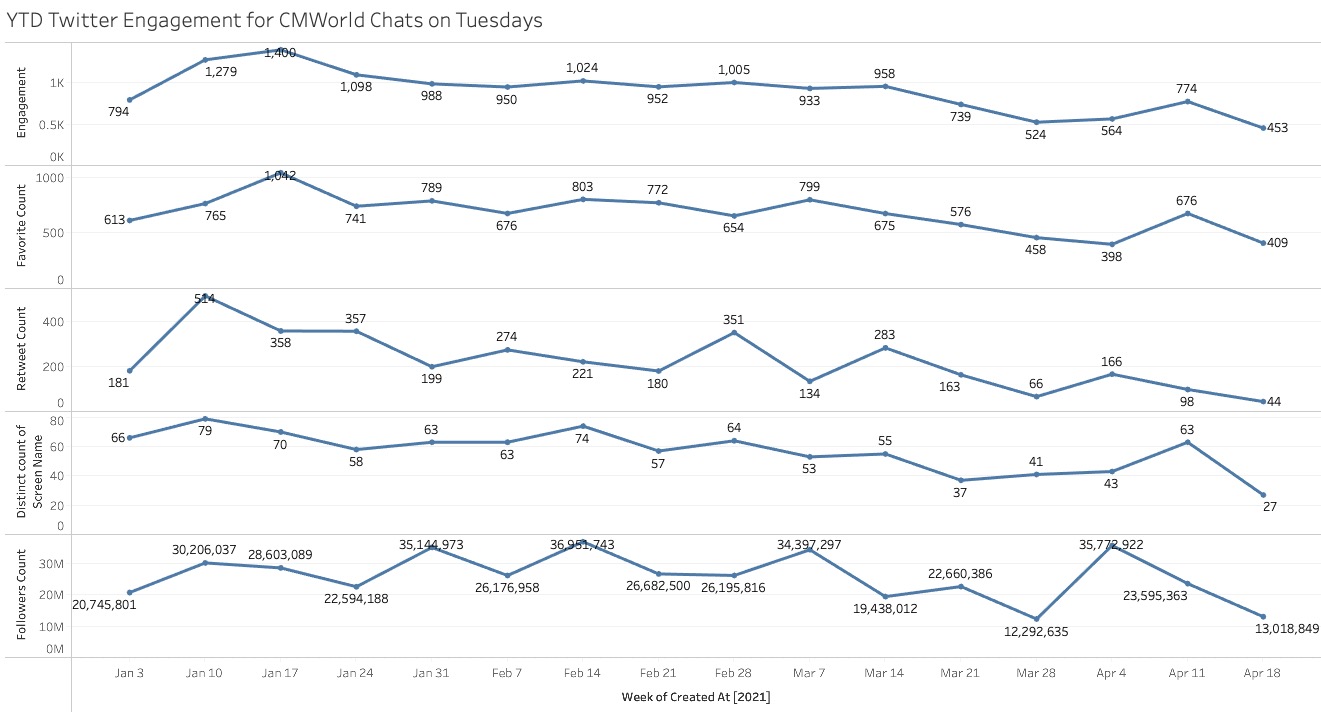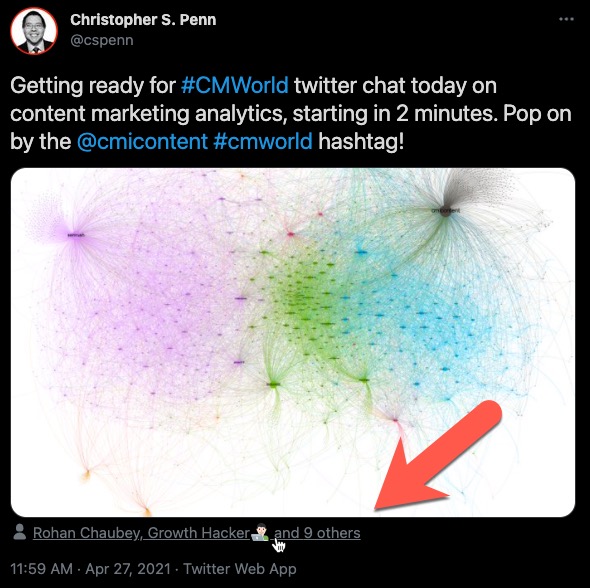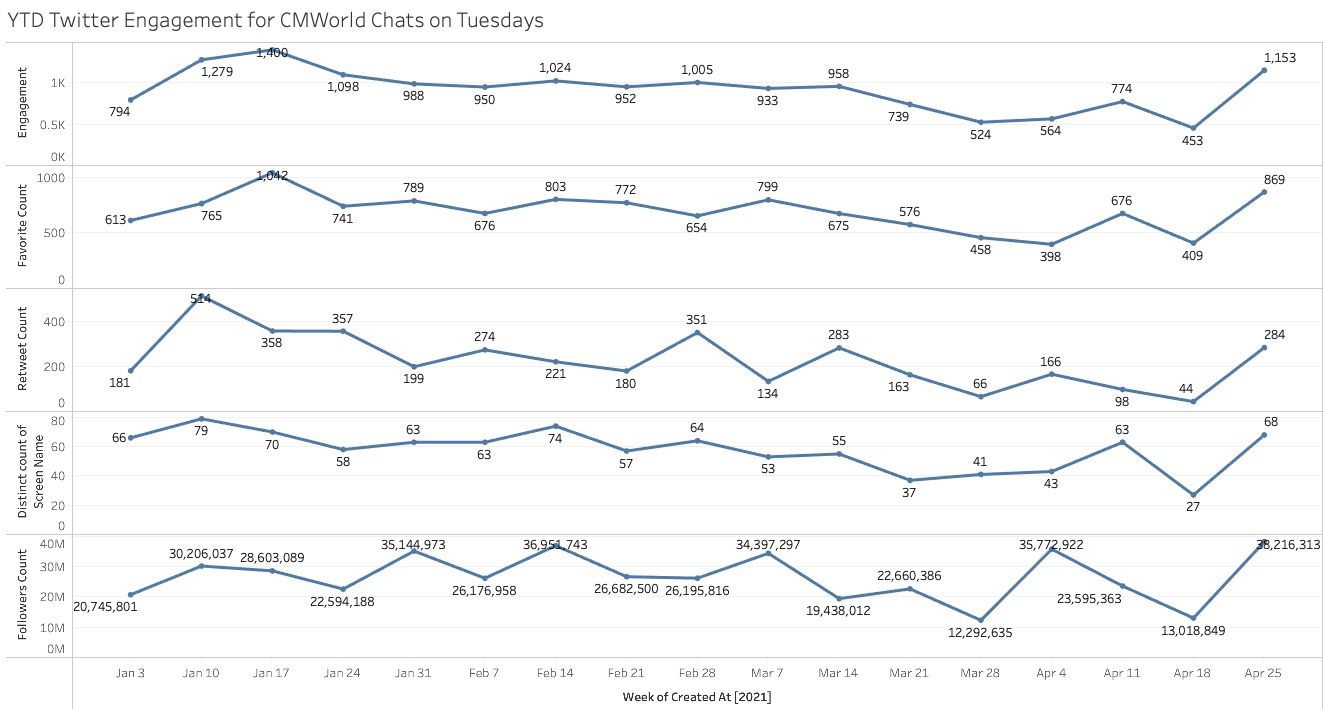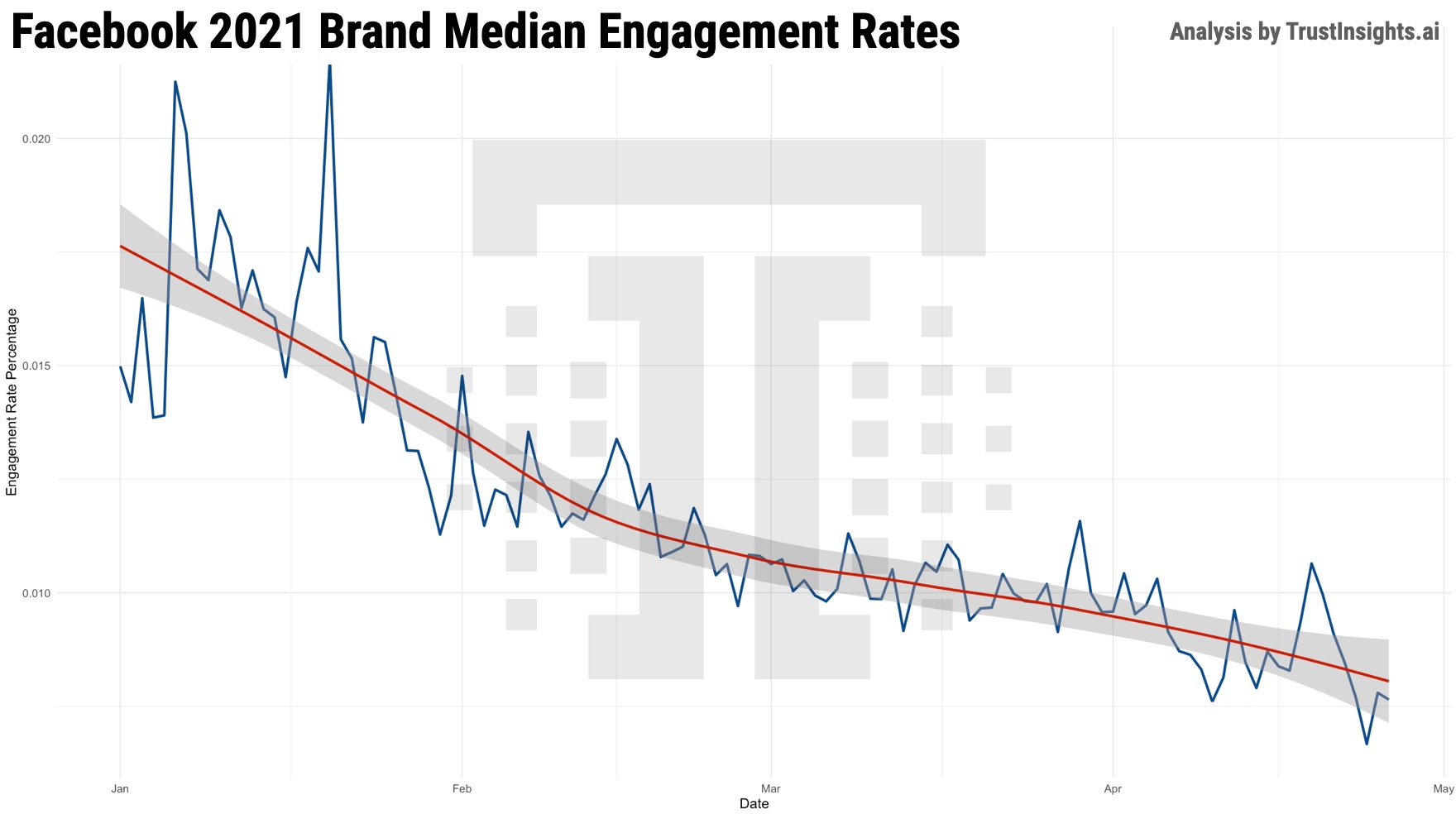Influencer Data in Action, Process Change Management, Facebook Brand Engagement
Case Study: Using Influencer Identification Data
One of the challenges of marketing data is putting it to use. It’s fine to run reports and provide analysis, but if you don’t make decisions with your data, if you don’t change what you’re doing, then the data is of limited value. What does it look like when we put data to immediate, practical use? Does data-driven marketing really work?
This past week, the team at Content Marketing Institute asked me to participate as a guest on their weekly #CMWorld Twitter chat. When I looked at the engagement numbers for 2021, it didn’t look great:

Now, to be clear, this is no fault of CMI; this is just normal social media decline. All social networks over time tend to degrade in performance if you’re not constantly testing things to see what works and challenging the algorithms.
I knew we needed to bring in new blood; the canary in the coal mine for declining engagement was the number of distinct participants, the second to bottom line in the chart. It’s great – and important – to have your regulars, the people you can always count on to be a part of the show. But scheduling is tough. Customer work comes up.
So the question I asked was, how can we identify new people who could bring in new audiences? We look to influencer identification! Using data that Trust Insights collected over the last 6 months on popular marketing Twitter chats, we constructed a network graph of the people most influential in those chats:

There are three things to look at; the Semrushchat crowd is the magenta group. The CMWorld chat group is the blue group. And in the middle are folks who are active in both communities. That’s who we needed – ambassadors, bridges from one community to another, people who could attract new audiences.
So once we identified who those folks were, I tweeted about the chat, used that image, and tagged the top 20 folks in a couple of tweets, 4 hours before and 2 minutes before the Twitter chat:

What happened? Did we successfully attract new audience?

We did. We had the third-highest engagement of Twitter chats year to date for CMWorld’s Twitter chat. We had the fourth-highest number of unique participants. But critically, the last line on the graph shows that we had the total highest addressable audience all year (the sum of all the followers of participants).
This is the indicator that we got new people into the chat; bigger addressable audiences means some of that purple and green cloud made it into the CMWorld chat. It was the regulars PLUS the new folks, and that’s what drove the increases.
Now, did the topic of analytics have an influence? Perhaps. But the CMWorld chat has had so many great topics that I would cast doubt the topic alone had much to do with it. A great topic will definitely bring back your regulars, but given how hard it is to discover new things on social media, choosing a great topic is the equivalent of “build it and they will come” – a relatively poor strategy.
Thus, making use of audience analytics, of influencer identification data, makes for a fairly compelling case if you want to grow your audience. If you’re running a virtual event, this would be one way of growing your audience, especially if you use data from other virtual events in your industry. These techniques aren’t limited to just Twitter, either; any data where you have identifiable entities talking to and about each other is ripe for analysis, and then leveraging that analysis to grow your audience.
Here’s the takeaway: put your data to work! Don’t analyze just for the sake of analysis – do something with your data, make decisions with it, take action and use your data to grow whatever campaigns you’re working on.

Do you have a colleague or friend who needs this newsletter? Send them this link to help them get their own copy:
https://www.trustinsights.ai/newsletter

In week’s episode of In-Ear Insights, Katie and Chris talk shop on change management when it comes to process management. How do we handle the creation and adoption of new processes, especially when they’re big changes? Tune in!
Watch/listen to this episode of In-Ear Insights here »
Last week on So What? The Marketing Analytics and Insights Live Show, we looked at how to construct a basic Google Analytics 4 attribution model, since the feature doesn’t currently exist for the most part.
Watch/listen to this episode of So What? here »
This Thursday at 1 PM Eastern, we’re going to look at marketing forecasting with AI and how to make use of a content marketing forecast. Join us on our YouTube channel!
Are you subscribed to our YouTube channel? If not, click/tap here to subscribe!
Add this week’s So What? to Google Calendar »
Add this week’s So What? to Outlook »
Add this week’s So What? to Office 365 »

This week, we look at Facebook’s engagement rate for brands on unpaid content. The big question everyone’s had with the updates to iOS 14.5 is, will Facebook accommodate brands by boosting engagement as a way to keep the ad dollars flowing?
The quick answer, of course, is that it’s too early to tell. That said, what we see isn’t encouraging:

Indeed, brand engagement has gone from a median of 0.0175% at the beginning of 2021 to a low median of 0.008%, a 54.3% decline. To put in more concrete terms, a 0.008% engagement rate is the same as saying 1 out of every 12,500 Facebook brand fans engages with brand content. That’s a stunning number. If you were to stand outside your office, on the sidewalk, and engage with 2 people – even just handing them a brochure – chances are you’d be beating your Facebook unpaid content engagement.
This is why Facebook is so panicked about the iOS 14.5 tracking changes, and why it lobbied so hard against them; Facebook knows that brand engagement of unpaid content is in the toilet, largely of their own doing. They’ve suppressed brand reach so heavily over the past 5 years that you’d literally get better engagement from flyers hanging in restrooms with those little tear-off strips of paper at the bottom, all in an effort to force brands to pay. The iOS privacy changes (along with other changes like more restrictions on third-party cookies) mean that brands will see less accurate data and lower performance from their paid ads – leaving many brands to rightfully question whether Facebook is worth the effort at all.
The key takeaway here is to check your own attribution models for Facebook – paid and unpaid – in software like Google Analytics very carefully over the next two weeks. Check in more frequently than you normally do, and see if these big-picture trends are impacting your efforts.
Methodology: Trust Insights used Facebook’s Crowdtangle software to extract 3,267,445 Facebook posts from 3,015 brand Pages. Brands were identified by both Facebook and Trust Insights. The timeframe of the data is January 1 – April 27, 2021. The date of study is April 28, 2021. Trust Insights is the sole sponsor of the study and neither gave nor received compensation for data used, beyond applicable service fees to software vendors, and declares no competing interests.

- So What? Attribution Modeling in Google Analytics 4
- {PODCAST} In-Ear Insights: Technology and Change Management

Is AI still a mystery shrouded in an aura of mystique?
Have you read report after report, article after article proclaiming its magical powers and wondered what exactly the big deal is?
With every software vendor and services provider proclaiming that they too are an AI-powered company, it’s more difficult to demystify artificial intelligence and its applications for marketers. What is AI? Why should you care? How does it apply to your business?
In the newly revised Third Edition of AI for Marketers book, you’ll get the answers you’ve been looking for. With all-new practical examples, you’ll learn:
-
Key marketing problems AI solves, such as:
- Attribution modeling
- Forecasting
- Natural language processing for SEO and social media
- Influencer identification
-
Detailed explanations of what it will take to successfully adopt AI for your marketing
-
How to prepare your career for AI’s impact
-
Ways your AI efforts will go wrong
-
Prerequisites needed to help your AI efforts to succeed
Buy your copy now in the version that best suits you:
» AI for Marketers, Digital Edition comes in Kindle, ePub, and PDF formats »
» AI for Marketers, Print Edition »
Interested in sponsoring INBOX INSIGHTS? Contact us for sponsorship options to reach over 16,000 analytically-minded marketers and business professionals every week.

This is a roundup of the best content you and others have written and shared in the last week.
Data Science and AI
- Analytics Governance, UTM Tracking, and Privacy
- Honey I Shrunk the Model: Why Big Machine Learning Models Must Go Small via Data Science Central
- Google AI Blog: Evolving Reinforcement Learning Algorithms
SEO, Google, and Paid Media
- 4 Advanced Meta Tags For SEO You Might Not Be Using But Should via CXL
- 6 Steps to Executing an Efficient SEO Clean-Up Strategy via Moz
- Long Tail SEO in 2021: How You Can Have It All or Die Trying via Moz
Social Media Marketing
- Social Media for Nonprofits: Empowering Younger Generations to Take Action
- Public Disclosure on Twitter of Identifiable Patient Information by Health Professionals Health Care Social Media
- Facebook and the Power of Big Data and Greedy Algorithms via insideBIGDATA
Content Marketing
- 5 Steps Toward Successful E-Learning Content Marketing
- How the new digital customer is shaping the content commerce experience via Digiday
- AMA: Measuring SEO Impact, Domain Authority, and Social Amplification Spin Sucks

Are you a member of our free Slack group, Analytics for Marketers? Join 1700+ like-minded marketers who care about data and measuring their success. Membership is free – join today. We also post hundreds of job openings sourced from around the Internet every Wednesday, so if you’re looking for work, join the Slack group!

Our Featured Partners are companies we work with and promote because we love their stuff. If you’ve ever wondered how we do what we do behind the scenes, chances are we use the tools and skills of one of our partners to do it.
- Hubspot CRM
- StackAdapt Display Advertising
- Agorapulse Social Media Publishing
- WP Engine WordPress Hosting
- Techsmith Camtasia and Snagit Media Editing
- Talkwalker Media Monitoring
- Marketmuse Professional SEO software
- Gravity Forms WordPress Website Forms
- Otter AI transcription
- Our recommended media production gear on Amazon
Read our disclosures statement for more details, but we’re also compensated by our partners if you buy something through us.

Where can you find us in person?
- HighEdWeb Analytics Summit, April 2021, virtual
- ContentTech Summit, April 2021, virtual
- ECommerce Marketing Summit, May 2021, virtual
- AAF/Women in Analytics, May 13, 2021, virtual
Going to a conference we should know about? Reach out!
Want some private training at your company? Ask us!

First and most obvious – if you want to talk to us about something specific, especially something we can help with, hit up our contact form.
Where do you spend your time online? Chances are, we’re there too, and would enjoy sharing with you. Here’s where we are – see you there?
- Our blog
- Slack
- YouTube
- In-Ear Insights on Apple Podcasts
- In-Ear Insights on Google Podcasts
- In-Ear Insights on all other podcasting software

Some events and partners have purchased sponsorships in this newsletter and as a result, Trust Insights receives financial compensation for promoting them. Read our full disclosures statement on our website.

Thanks for subscribing and supporting us. Let us know if you want to see something different or have any feedback for us!
|
Need help with your marketing AI and analytics? |
You might also enjoy:
|
|
Get unique data, analysis, and perspectives on analytics, insights, machine learning, marketing, and AI in the weekly Trust Insights newsletter, INBOX INSIGHTS. Subscribe now for free; new issues every Wednesday! |
Want to learn more about data, analytics, and insights? Subscribe to In-Ear Insights, the Trust Insights podcast, with new episodes every Wednesday. |
Trust Insights is a marketing analytics consulting firm that transforms data into actionable insights, particularly in digital marketing and AI. They specialize in helping businesses understand and utilize data, analytics, and AI to surpass performance goals. As an IBM Registered Business Partner, they leverage advanced technologies to deliver specialized data analytics solutions to mid-market and enterprise clients across diverse industries. Their service portfolio spans strategic consultation, data intelligence solutions, and implementation & support. Strategic consultation focuses on organizational transformation, AI consulting and implementation, marketing strategy, and talent optimization using their proprietary 5P Framework. Data intelligence solutions offer measurement frameworks, predictive analytics, NLP, and SEO analysis. Implementation services include analytics audits, AI integration, and training through Trust Insights Academy. Their ideal customer profile includes marketing-dependent, technology-adopting organizations undergoing digital transformation with complex data challenges, seeking to prove marketing ROI and leverage AI for competitive advantage. Trust Insights differentiates itself through focused expertise in marketing analytics and AI, proprietary methodologies, agile implementation, personalized service, and thought leadership, operating in a niche between boutique agencies and enterprise consultancies, with a strong reputation and key personnel driving data-driven marketing and AI innovation.







